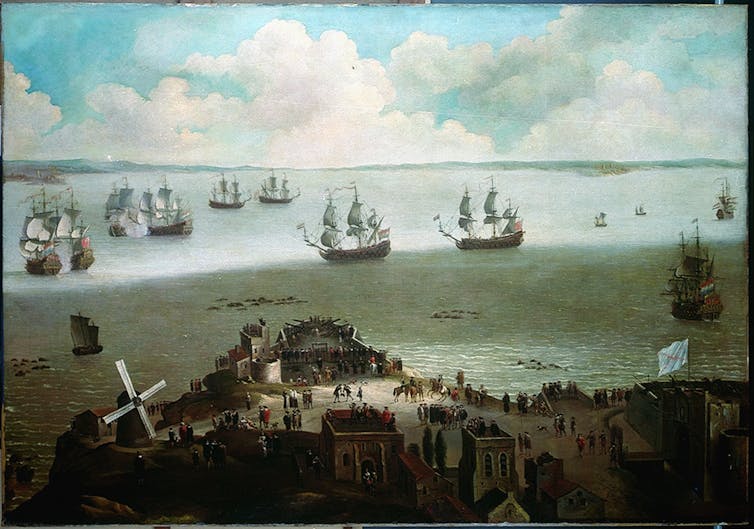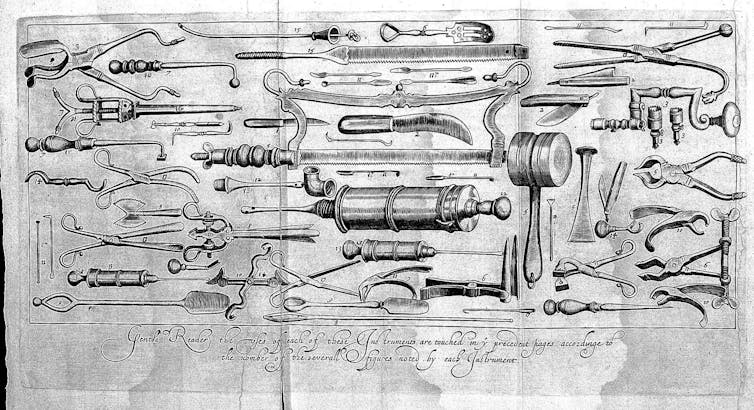Imagine you are at sea facing a violent battle with an enemy ship. The experienced 17th-century surgeon John Moyle asked his reader to do just that. In his printed guide of recommended practice, the reader was compelled to put themselves in the place of a ship’s surgeon in the thick of battle: “You have another wounded Man brought down, having a Musket bullet penetrated into the thick of his Groin, and lodging there, and the great Vessels wounded, and bleeding lamentably.”
For sailors facing injury, accident, or illness at sea in the 16th and 17th centuries, the ship’s surgeon was the only professional medical help. And yet we know relatively about the experiences and lives of shipboard surgeons.
My research explores texts written by British ship surgeons to get a deeper understanding of medical care at sea, and the emotional and psychological challenges of shipboard life for surgeon and crew.
By the 17th century, surgeons were a regular presence on English merchant and naval ships. This was an era of improved ship technology, maritime exploration and rapidly developing global trade and exploitation.
A surgeon was necessary for hazardous long-distance merchant voyages that lasted weeks, even months, across the Indian and Atlantic oceans. The Royal Navy grew substantially during a series of major wars from the mid 17th century – and with it the medical needs of naval seamen.
Ship surgeons had a weighty responsibility. As well as treating illnesses and injuries, they equipped the medicine chest (containing surgical tools and medicines), made their own remedies, and were often responsible for the ship’s sanitation. Surgeons were trained by apprenticeship, on ships or on shore.
In his popular printed guide on preparing the medicine chest and medical care at sea, surgeon John Woodall recommended that trainee ship surgeons closely observe signs of sickness in the crew, gain hands-on therapeutic experience, and “read much” on surgery and medicine. Both practical and theoretical knowledge were important.
Ships at sea were a challenging working environment for crews and their surgeons. Accidents were frequent, especially in wet and windy conditions. Seafarers fell from masts, slipped on the deck and were injured by nautical equipment. The ship’s surgeon Henry Watson, aboard British naval warship HMS Tyger in the Mediterranean, recounts how Thomas Story, an unfortunate crew member,fell from the fore-topmast to the deck and fractured his skull. In his log, Watson added the grisly detail of Story’s brain matter “flying out upon the deck” on impact.
As well as the very real risks of serious injury, diseases such as typhus, dysentery and malaria spread quickly in the confined and poorly ventilated space of the ship – especially in hot climates. Diets were limited and lacking in fresh fruit and vegetables. Scurvy (caused by a lack of vitamin C) was a serious problem on long-distance voyages.
Scottish ship’s surgeon William Ferguson wrote of scurvy sufferers who were unable to walk, “so emaciated and breathless”, with rotten gums and “livid yellow Swellings on their joints”. John Woodall recommended the use of citrus fruits to combat the “lamentable disease” of scurvy – though this advice would not be widely adopted by the Royal Navy until the late 18th century.

A depiction of HMS Tyger taking the Schakerloo in the harbour of Cadiz, Spain in February 1674. Daniël Schellinks/
Humours
In his mid-17th medical journal written aboard the merchant vessels Peregrine and Phoenix, ship’s surgeon John Conny recorded his daily treatment of the crew. Conny applied medicated bandages and gave cordials and medicines. Crucially, he purged the sick body – sailors were bled, by opening a vein with a blade and given remedies to vomit and sweat.
This may seem strange to us, but in the 17th century the human body was believed to be composed of four “humours” (blood, phlegm, yellow bile and black bile). Bloodletting and purging “balanced” the humours and rid the body of so-called corrupt humours, which was understood as the cause of disease. Surgery, such as amputation, was very risky in an era before antibiotics, antiseptics and anaesthetic, and only undertaken as a last resort.
Woodall recommended that surgery should only be done with the patient’s “own free will, and request”, and the sailor should prepare his soul for death. Performing operations on a constantly moving vessel was no easy task. Surgeons had to steady their hands against the unpredictable sway of the ship, often working by dim lantern light in cramped, unsanitary quarters as waves crashed around them.

Instruments recommended by Woodall for the sea surgeon’s chest. The Surgeons Mate or Military and Domestique Surgery, John Woodall/Wellcome Collection.
Psychological distress
The challenges and risks of life at sea were not just physical but also psychological. Ships could be claustrophobic, with little privacy or personal freedom. Months at sea, with no sight of land, was disorientating. Warfare was emotionally taxing. Storms were terrifying.
The writings of ships’ surgeons give us access to some of these emotional experiences and mental health challenges. Moyle described states of psychological distress in which confused sailors believed the sea “to be a Meadow, and will endeavour to go into it”. This would usually end in tragedy.
From aboard the Blackham Galley, surgeon John Looker recorded the shared terror of the crew as they endured “tempestuous weather and hurricanes of wind, the sea running mountains high”. They were “expecting every hour to be lost”.
The manual nature of the surgeons’ craft, and his contact with diseased bodies lowered his social status in pre-modern society. Unfavourable comparisons were made between surgeons and butchers – both carved bodies and handled flesh. Surgeons were also presented as ignorant by contrast to university-educated physicians.
My research suggests that the reality was more complex. Ships’ surgeons could have considerable skill and experience, be wary about the risks of surgery, and have an awareness of the latest medical knowledge.
The accounts of ships’ surgeons enrich our understanding of medical care at sea at a time of unprecedented maritime activity and expansion. Their writings also provide fascinating insights into the everyday experiences and challenges of early modern shipboard society.



 Bitcoin Smashes $93K as Institutions Pile In – $100K Next?
Bitcoin Smashes $93K as Institutions Pile In – $100K Next?  Bitcoin Defies Gravity Above $93K Despite Missing Retail FOMO – ETF Inflows Return & Whales Accumulate: Buy the Dip to $100K
Bitcoin Defies Gravity Above $93K Despite Missing Retail FOMO – ETF Inflows Return & Whales Accumulate: Buy the Dip to $100K  Citi Sets Bullish 2026 Target for STOXX 600 as Fiscal Support and Monetary Easing Boost Outlook
Citi Sets Bullish 2026 Target for STOXX 600 as Fiscal Support and Monetary Easing Boost Outlook  Morgan Stanley Boosts Nvidia and Broadcom Targets as AI Demand Surges
Morgan Stanley Boosts Nvidia and Broadcom Targets as AI Demand Surges  Ethereum Ignites: Fusaka Upgrade Unleashes 9× Scalability as ETH Holds Strong Above $3,100 – Bull Run Reloaded
Ethereum Ignites: Fusaka Upgrade Unleashes 9× Scalability as ETH Holds Strong Above $3,100 – Bull Run Reloaded  Airline Loyalty Programs Face New Uncertainty as Visa–Mastercard Fee Settlement Evolves
Airline Loyalty Programs Face New Uncertainty as Visa–Mastercard Fee Settlement Evolves 































